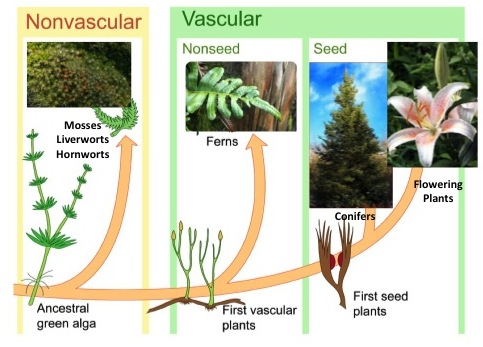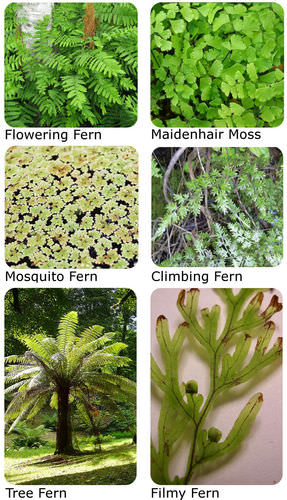Vascular Plants Study Guide
Introduction
Vascular plants are also called tracheophytes. Tracheophyta is derived from the Greek word trachea, which means a duct–a channel in plants. The vascular plants are well-ordered, as are the land plants, including blooming vascular plants and ferns. They have developed a sophisticated network of vascular systems that run throughout the plant body, allowing for the efficient transfer of water, nutrients, and signals.
Vascular plants are advanced and well-developed plants that include ferns, seed plants, angiosperms, and gymnosperms. Vascular tissues of vascular plants include the xylem and phloem, which convey water and integrate food, respectively.
Definition of Vascular Plants
The word “vascular,” which often refers to a small vessel, comes from the Latin word “vasculum,” which means “a container and column.” Xylem and phloem, which are vital for transferring water, are examples of vascular tissues found in compact vascular plants which are essential for transporting minerals and nutrients.
Features of Vascular Plants
The properties of vascular plants are determined by their architecture; nevertheless, the presence of vascular tissues in the plants is the most important feature of a vascular plant. Other common qualities or properties of vascular plants include:
- As previously stated, vascular plants have vascular tissues and vascular bundles (xylem and phloem). These specialized structures allow vascular plants to grow in size.
- The reproduction includes generational alternation, with sporophyte as the generation face and gametophyte as the generation back.
- Almost all vascular plants have real leaves, stems, and roots; nevertheless, certain vascular plants may have decreased features.
Vascular and Nonvascular plants

- The primary distinction between vascular and nonvascular plants is that vascular arteries transport water and food to all plant areas.
- The phloem is the vessel that delivers food, whereas the xylem transports water.
- A nonvascular plant, on the other hand, lacks a vascular system. This implies that nonvascular plants are significantly smaller than vascular plants, and this is one of the simplest methods to tell the difference between the two.
- Another distinction is that a nonvascular plant lacks roots, but a vascular plant does. On the other hand, a nonvascular plant possesses rhizoids, which are tiny hairs that maintain the plant in place.
- The roots of a vascular plant offer support and absorb water from the environment.
- Nonvascular plants are most typically found in damp conditions, where they receive adequate water without relying on roots.
- Nonvascular plants have simpler reproductive techniques than vascular plants. Most nonvascular plants reproduce asexually by creating single-celled spores or asexually through vegetative propagation, in which a new plant develops from a piece of the original plant.
- Vascular plants include club mosses, horsetails, ferns, gymnosperms, and angiosperms (flowering plants).
- Mosses, liverworts, and hornworts are three nonvascular plant examples with flattened, green plant bodies.
Structure of Vascular Plants
The internal structure of a vascular plant differs significantly from that of a non-vascular plant. There is minimal to no differentiation between the many cells in non-vascular plants. Depending on the division and species to which the vascular plant belongs, the specialized vascular tissues are organized in different ways in vascular plants.
The xylem is specialized in moving water and minerals from the roots to the leaves and is primarily composed of the structural protein lignin and dead cells. This is accomplished by vascular plants by exerting pressure on the water from various angles. Water is absorbed by the tissues in the roots. Water enters the xylem and exerts upward pressure there. Water is consumed at the leaves and escapes the stoma as evaporation. The water column in the xylem is said to be pulled higher by these tiny pores, which are known to transpire. The water flows upward through the xylem like liquid through a straw due to the adhesion and cohesion processes.
Photosynthesis occurs in the leaves. A vascular plant uses the same method to capture solar energy and store it in the bonds of glucose as do lower plants and algae. The stem and roots of the plant, which are unable to photosynthesize, require the transportation of this modified sugar in different forms. The phloem was created specifically for this function.
Phloem, in contrast to xylem, consists of partially alive cells that aid in the transportation of carbohydrates via transport proteins located in cell membranes. The phloem and xylem are interconnected, and the phloem can contribute water to help move and dilute the sugar. This is known as sap or syrup, such as maple syrup, when it is harvested commercially.
Examples of Vascular Plants
Ferns
- A fern is an example of a lower vascular plant with a special conductive tissue called xylem and phloem that allows the flow of water, minerals, and food particles.
- These are non-flowering vascular plants with genuine stems, roots, and leaves that reproduce through spores.
- These plants have distinct environments, morphologies, and reproductive systems.
- Ferns like wet, warm conditions, and their numbers drop as altitude and moisture levels rise.
- Ferns are important in ecological succession because they grow in exposed rock cracks and marshy areas before woody growth.
- Due to these plants’ ability to disseminate spores, generate gametes, and self-fertilize, long-distance dispersion is possible.
Cycad
- Cycads are non-flowering vascular plants with formed roots, stems, leaves, and vascular systems.
- These are massive trees that may reach three to five feet in height and have woody stems.
- These plants are common in forests, but they are also grown by farmers for timber and animal feed.
- Female plants produce seed cones rather than a cluster of leaf-life structures holding seeds, making these plants deciduous and unusual among gymnosperms.
- Cycads such as C. circinalis and C. beddomei are planted as beautiful gardens.
- Cycads are sometimes known as sago palms because some species produce starch called sago from their stems.
- The leaves are often utilized in flower arrangements and other ornamental reasons.
Conclusion
- Vascular plants are sophisticated plants with a transportation function via xylem and phloem.
- The two forms of vascular tissue — xylem and phloem, transport water, minerals, and photosynthetic products throughout the plant.
- An vascular plant, as opposed to a nonvascular plant, may grow significantly larger.
FAQs
1. Do vascular plants have roots?
Vascular plants are known as tracheophytes. The xylem and phloem are vascular tissues, and they enable plants to grow tall in the air without becoming wilted. Vascular plants contain roots, stalks, and leaves as well.
2. What are the 3 types of vascular plants?
Vascular plants include ferns, gymnosperms, and flowering plants. These plants have genuine stems, leaves, and roots because they have vascular tissues.
3. Is coconut tree a vascular plant?
The stem tissue of the coconut palm is a complicated fibrovascular system composed of fibrovascular bundles embedded in parenchymatous ground tissue.
4. What is the simple definition of a vascular plant?
A vascular plant is any of several plants that have specialized vascular tissue. The two forms of vascular tissue, xylem and phloem, transport water, minerals, and photosynthetic products throughout the plant.
5. Give some examples of vascular and nonvascular plants.
Mustard, maize, cycad, rose, ferns, clubmosses, grasses are examples of vascular plants. On the other hand, algae, moss, hornwort, and liverwort are examples of nonvascular plants.
6. Is a rose a vascular plant?
Yes, Rose is a vascular plant.
We hope you enjoyed studying this lesson and learned something cool about Vascular Plants! Join our Discord community to get any questions you may have answered and to engage with other students just like you! Don’t forget to download our App to experience our fun, VR classrooms – we promise, it makes studying much more fun! 😎
]]>
